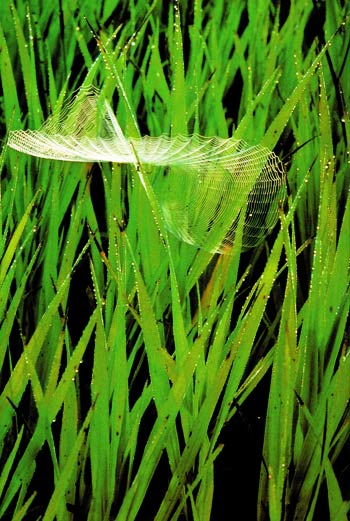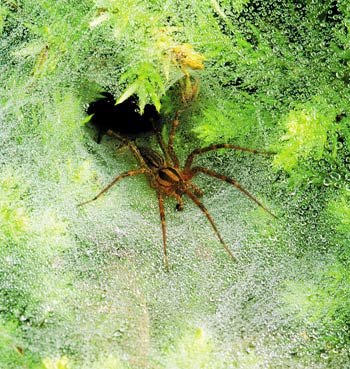Conclusion
So why do they) worship, instead of God, things that have no control over their provision from the heavens or earth in any way, and are themselves completely impotent? Do not try to make metaphors for God. God knows and you do not know. (Surat an-Nahl: 73-74)
The theory of evolution is a speculative claim, unsupported by any scientific criteria and based on no valid evidence. Beyond this, its claim that every living creature should have emerged as a result of countless, completely improbable coincidences, is based on a foundation totally lacking in any intelligence or science.
Despite this, evolution is the only hope that certain ideological circles have embraced to keep society at large from the truth. For this reason, and despite all arguments to the contrary, they are still trying to keep it on the agenda. Yet the theory of evolution is helpless in the face of the spider, which we have examined throughout this book, as it is in the face of every living thing created in nature; it is quite unable to explain how the features which spiders possess should have come about.
 If we consider the features possessed by spiders from the point of view of evolution, we can better understand what an unsound claim the theory of evolution is. Let us consider a species of insect which we shall imagine as the ancestor of all spiders. Let us imagine that this creature is deaf and almost blind, like many spiders today. In such a state it should be unable to hunt anything and immediately die of hunger. But, somehow or other, this insect managed to stay alive, by coincidence or some other inexplicable force.
If we consider the features possessed by spiders from the point of view of evolution, we can better understand what an unsound claim the theory of evolution is. Let us consider a species of insect which we shall imagine as the ancestor of all spiders. Let us imagine that this creature is deaf and almost blind, like many spiders today. In such a state it should be unable to hunt anything and immediately die of hunger. But, somehow or other, this insect managed to stay alive, by coincidence or some other inexplicable force.
One day this blind and deaf insect has the bright idea of building a web for hunting. That would mean having somewhere to live as well as an ideal trap for hunting. But this insect does not possess the architectural capacity and calculating ability necessary to make a web. One by one it needs to calculate the speed of the wind and the prey it will trap, the loads the web will have to bear, the spread of these loads, the load-bearing capacity of the plants and leaves, etc., on which it will build its web, and many other details. At this point the question, "How can a spider make calculations?" may arise. But it must not be forgotten that this is the basic logic of evolution: evolution, in its attempt to deny creation, has no alternative but that the insect performed these calculations itself.
Nevertheless, even if we accept that the insect has the intelligence to plan the construction of a web, it still cannot escape death; because it lacks the tools to make the web. Tools with the properties essential to the job do not exist in nature. This being the case, it decides to produce the thread to make its web. But once again it faces a huge problem; how is it to produce this thread?
Having said which, that force known as coincidence again enters the equation, a number of changes take place inside the insect's body, and suddenly six different glands emerge perfectly formed in its lower body ready to give off the chemical liquids. Then these glands begin to function under equal pressure and time systems. Again by coincidence, the chemical liquids produced by these glands mix with each other in particular proportions and the raw material of spider thread emerges. By another coincidence, and at the same time, the spinnerets on its back legs spin the fibres and a perfect thread for the insect is produced. So helpful is coincidence that the emerging thread is five times stronger than steel and thirty percent more elastic than rubber. This thread, with its various molecular characteristics, which cannot be completely imitated by man, has been planned by a tiny little insect.
Next, the insect weaves a web, sometimes using sticky and elastic threads, at other times rigid and strong ones. What a lucky coincidence that the insect's legs are seven-jointed to enable it to walk on the web! And another product of so-called coincidence was already on its feet, the special coating to stop it sticking to its own web. And the coincidences do not end here. The body of this deaf and almost blind insect was already covered in special hairs capable of sensing the slightest vibration on the web, from the very first day it wove the web. And so today's spider emerges as a result of coincidentally acquired capabilities which we have been unable to detail here.
It is quite evident from an examination of this scenario what an unintelligent hypothesis the theory of evolution is. One important point must be made here. Firstly, the features the spider possesses can in no way have come about over time. The abilities under discussion must all have been in place in the spider at the same time. There can be no such thing as a spider which knows how to make a web but cannot produce silk, or which can produce silk but does not know how to build a web. As for spiders which do not build webs, such as the jumping spider, these were created together with greater properties which have given the lie to evolution thousands of times.
If the spider can spin the most beautiful webs, but there is not the sticky material which it spreads over its web, then it will still serve no purpose. If the sticky material is there, but this time the molecular features which give the sticky threads their elasticity are lacking, which would be perfectly natural, then the web will still serve no purpose and the spider will die.
A spider which possesses all the mechanisms necessary for making silk, but does not receive the material known as scleroprotein from the food it digests, can still not spin silk. Despite all this, if it coincidentally comes by a web, then it needs the chemical coating on its feet to enable it to walk on the web without getting stuck to it. At the same time a sensory system is necessary to perceive the vibrations on the web. If even one of all of these features is lacking, then the spider will shortly die.
 The spider has respiratory, digestive, and circulatory systems. Like the others, these systems must have emerged at the same time. We cannot imagine a spider without a stomach or a heart. It follows that for all the other organs like the web-making organs to exist, the genetic codes for these organs must exist in every one of the millions of cells which go to make up the spider. A new organ means extra information in the millions of stages in DNA, the genetic code. A change in one of these stages means that the new organ will serve absolutely no purpose. (For more detailed information, see Harun Yahya, The Miracle In The Cell, Istanbul, Vural Publishing).
The spider has respiratory, digestive, and circulatory systems. Like the others, these systems must have emerged at the same time. We cannot imagine a spider without a stomach or a heart. It follows that for all the other organs like the web-making organs to exist, the genetic codes for these organs must exist in every one of the millions of cells which go to make up the spider. A new organ means extra information in the millions of stages in DNA, the genetic code. A change in one of these stages means that the new organ will serve absolutely no purpose. (For more detailed information, see Harun Yahya, The Miracle In The Cell, Istanbul, Vural Publishing).
Another point requiring attention is that a spider just emerged from the egg has the knowledge necessary to spin a web without receiving any training. By virtue of this knowledge generations of spiders are born capable of spinning webs. The baby spider receives absolutely no training, and attends no courses.
A construction engineer has to study at university for at least four years to acquire the knowledge necessary to put up a building. He uses hundreds of already printed academic works as a source. He performs his calculations on a computer. He has teachers to guide him and teach him to perform the calculations. The building of a web, several hundred times bigger than the spider, requires at least the same amount of calculation as constructing a building. It is not even sufficient to be a university graduate to plan and calculate the tension in the threads which make up the web, the strength of the foundation the web sits on, the correctness of the geometric form, the resistance and elasticity to be given to allow for the wind and the movement of the prey, the threads' physical and chemical properties, and many other details which we have not been able to list. In any case, there is no university for baby spiders. Shortly after coming into the world they begin to produce thread, build webs, and hunt.
Evolutionist scientists, unable to explain the reason for this, desperately resort to another utterly comic claim. According to this logic, which denies basic creation, an unknown force, known as instinct, tells the newly-born spider what it has to do.
So, what is instinct? Is it an inspiration, whose origins are unclear, which makes the spider a professor of physics and chemistry, a construction engineer, and an architect? What is the source of this inspiration, said to be in the spider and to emerge by itself. Let us try to find this by examining the make-up of the spider.
Like all living creatures the spider is made up of proteins. These proteins are made up of amino-acids. Amino-acids, in their turn, are made by large molecules coming together. And molecules come about when atoms join together. Let us seek the answer to the above question here. Where exactly in the spider is this thing called instinct, which tells the spider how to make threads which man cannot imitate and produces incomparable works of architecture and engineering? In the proteins which make up its body? Or in the amino-acids which make up the proteins? Or in the molecules which make up the amino-acids? Or else in the atoms which make up the molecules? Which one of these is the source of the inspiration which evolutionists try to pass off as instinct?
Of course it is none of these. Like all living creatures, the spider submits to the Lord of all the worlds, and behaves as inspired by Him.
The seven heavens and the earth and everyone in them glorify Him. There is nothing which does not glorify Him with praise, but you do not understand their glorification. He is All-Forbearing, Ever-Forgiving. (Surat al-Isra': 44)
DİPNOTLAR
3. Gardner Soul, Strange Things Animals do, G.P.Putnam's Son, New York, 1970
4. Gardner Soul, Strange Things Animals do, G.P.Putnam's Son, New York, 1970
5.The Guinness Encyclopedia of the Living World, Guinnes Publishing, s. 164
6.David Attenborough, The Trials of Life, Princeton University Press, Princeton New Jersey, s.138
7.Liz Bornford, Camuflage and Colour, Boxtree Ltd., London, 1992, s. 108
8.The Guinness Encyclopedia of the Living World, Guinnes Publishing, s. 69-164
9.The Guinness Encyclopedia of the Living World, Guinnes Publishing, s. 164 
10. National Geographic, Kasım 1996, Vol. 190, No.5, s.106 
11.National Geographic, Kasım 1996, Vol. 190, No.5, s.111
12.The Guinness Encyclopedia of the Living World, Guinnes Publishing, s. 164
13. Görsel Bilim ve Teknik Ansiklopedisi, s.495
14. Hayvanlar Ansiklopedisi, C.B.P.C. Publishing lTd. Phoebus Publishing Company, s. 217 
